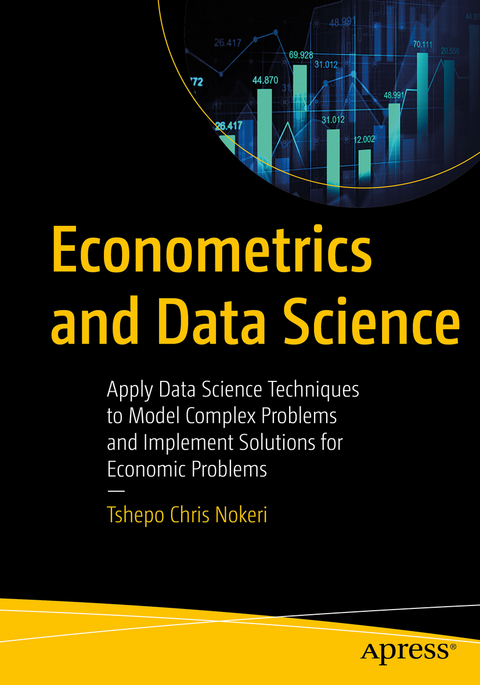
Econometrics and Data Science
Apress (Verlag)
978-1-4842-7433-0 (ISBN)
Author Tshepo Chris Nokeri begins by introducing you to covariance analysis, correlation analysis, cross-validation, hyperparameter optimization, regression analysis, and residual analysis. In addition, he presents an approach to contend with multi-collinearity. He then debunks a time series model recognized as the additive model. He reveals a technique for binarizing an economic feature to perform classification analysis using logistic regression. He brings in the Hidden Markov Model, used to discover hidden patterns and growth in the world economy. The author demonstrates unsupervised machine learning techniques such as principal component analysis and cluster analysis. Key deep learning concepts and ways of structuring artificial neural networks are explored along with training them and assessing their performance. The Monte Carlo simulation technique is applied to stimulate the purchasing power of money in an economy. Lastly, the Structural Equation Model (SEM) is considered to integrate correlation analysis, factor analysis, multivariate analysis, causal analysis, and path analysis.
After reading this book, you should be able to recognize the connection between econometrics and data science. You will know how to apply a machine learning approach to modeling complex economic problems and others beyond this book. You will know how to circumvent and enhance model performance, together with the practical implications of a machine learning approach in econometrics, and you will be able to deal with pressing economic problems.
What You Will Learn
Examine complex, multivariate, linear-causal structures through the path and structural analysis technique, including non-linearity and hidden states
Be familiar with practical applications of machine learning and deep learning in econometrics
Understand theoretical framework and hypothesis development, and techniques for selecting appropriate models
Develop, test, validate, and improve key supervised (i.e., regression and classification) and unsupervised (i.e., dimension reduction and cluster analysis) machine learning models, alongside neural networks, Markov, and SEM models
Represent and interpret data and models
Who This Book Is For
Beginning and intermediate data scientists, economists, machine learning engineers, statisticians, and business executives
Tshepo Chris Nokeri harnesses big data, advanced analytics, and artificial intelligence to foster innovation and optimize business performance. In his functional work, he has delivered complex solutions to companies in the mining, petroleum, and manufacturing industries. He initially completed a bachelor’s degree in information management. He then graduated with an honors degree in business science at the University of the Witwatersrand on a TATA Prestigious Scholarship and a Wits Postgraduate Merit Award. He was unanimously awarded the Oxford University Press Prize. He has authored two Apress books: Data Science Revealed: With Feature Engineering, Data Visualization, Pipeline Development, and Hyperparameter Tuning, and Implementing Machine Learning for Finance: A Systematic Approach to Predictive Risk and Performance Analysis for Investment Portfolios.
Chapter 1 Introduction to Econometrics.- Chapter 2 Univariate Consumption Study Applying Regression.- Chapter 3 Multivariate Consumption Study Applying Regression.- Chapter 4 Forecasting Growth.- Chapter 5 Classifying Economic Data Applying Logistic Regression.- Chapter 6 Finding Hidden Patterns in World Economy and Growth.- Chapter 7 Clustering GNI Per Capita on a Continental Level.- Chapter 8 Solving Economic Problems Applying Artificial Neural Networks.- Chapter 9 Inflation Simulation.- Chapter 10 Economic Causal Analysis Applying Structural Equation Modelling.
| Erscheinungsdatum | 29.10.2021 |
|---|---|
| Zusatzinfo | 107 Illustrations, black and white; XVIII, 228 p. 107 illus. |
| Verlagsort | Berkley |
| Sprache | englisch |
| Maße | 178 x 254 mm |
| Themenwelt | Mathematik / Informatik ► Informatik ► Datenbanken |
| Mathematik / Informatik ► Informatik ► Programmiersprachen / -werkzeuge | |
| Informatik ► Theorie / Studium ► Künstliche Intelligenz / Robotik | |
| Mathematik / Informatik ► Mathematik ► Wahrscheinlichkeit / Kombinatorik | |
| Wirtschaft ► Volkswirtschaftslehre ► Ökonometrie | |
| Schlagworte | Data Science • Deep learning • Econometrics • Keras • Logistic Regression • machine learning • Markov model • Neural networks • Statistics • Time Series Analysis • Unsupervised Learning |
| ISBN-10 | 1-4842-7433-4 / 1484274334 |
| ISBN-13 | 978-1-4842-7433-0 / 9781484274330 |
| Zustand | Neuware |
| Haben Sie eine Frage zum Produkt? |
aus dem Bereich


